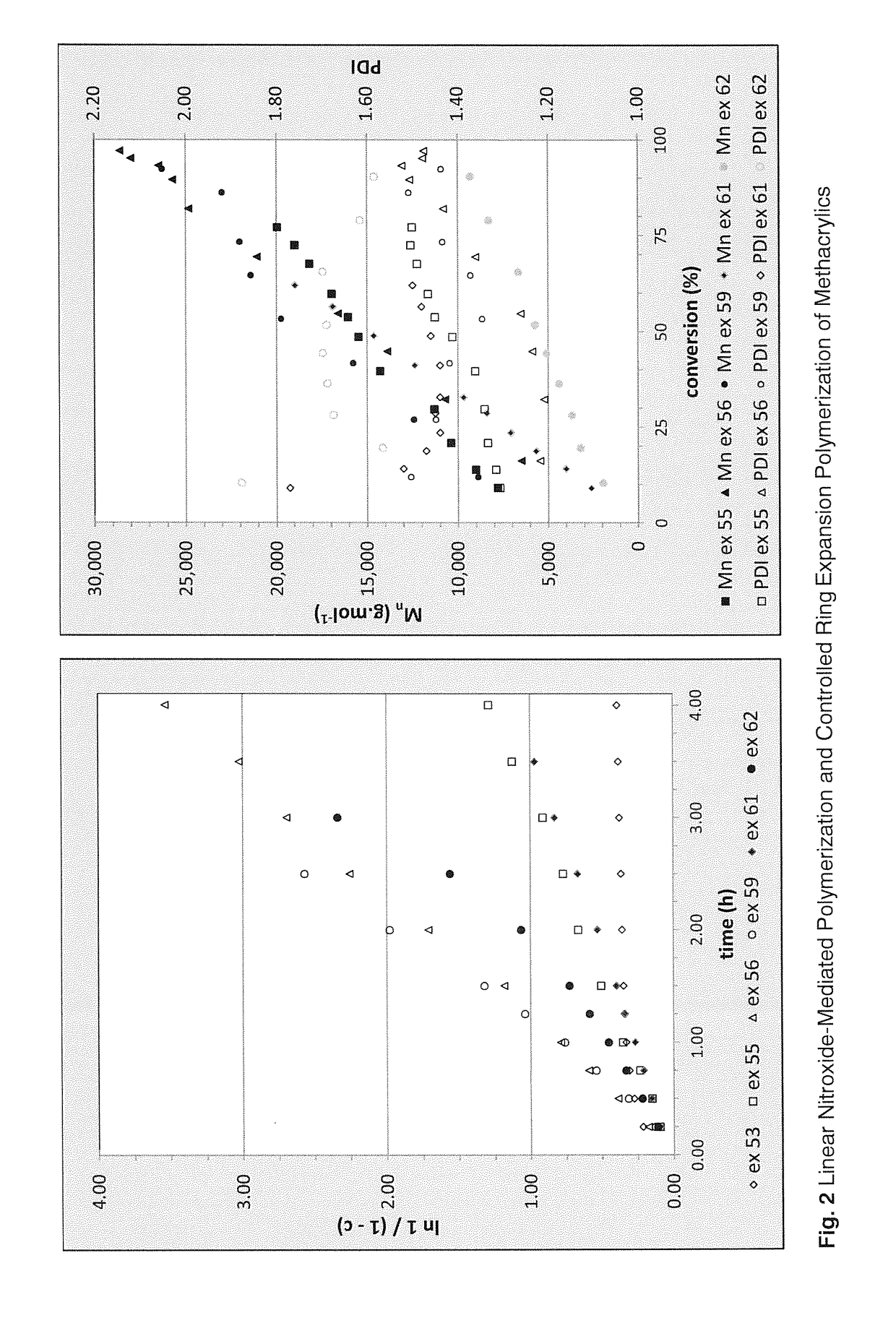Regulators for controlling linear and pseudo-ring expansion polymerization of vinyl monomers
a technology of regulator compounds and vinyl monomers, which is applied in the direction of organic compounds, group 5/15 element organic compounds, chemistry apparatus and processes, etc., can solve the problems of limiting the scope of industrialization of free radical polymerization, limiting the scope of industrialization, and the current scale of industrialization far from what has been predicted, so as to improve the control of composition and high conversion
- Summary
- Abstract
- Description
- Claims
- Application Information
AI Technical Summary
Benefits of technology
Problems solved by technology
Method used
Image
Examples
example 1
anomethylene)-2-methylpropan-2-amine oxide
[0175]Step 1: Into a 500-mL Erlenmeyer flask with stirrer bar were charged 252 mL (3 equiv) of tert-butylamine and 150 mL of ethyl acetate and the flask was cooled in a water bath. To this was added drop wise 60.4 g (50.6 mL, 0.8 mol) of chloroacetonitrile in 30 min and the resulting mixture was left to stir for 3 d at room temperature. The reaction mixture was filtered with the aid of 250 mL of ethyl acetate. The filtrate was washed with water, brine, dried over sodium sulfate and after filtration volatiles were evaporated to yield 73.6 g (82%) of a colorless liquid of greater than 98% purity (1H NMR) and suited as such for further use. 1H NMR δ 1.11 (s, 9H, t-Bu), 1.17 (br, 1H, N—H), 3.53 (s, 2H, CH2); 13C NMR δ 28.91 (t-Bu), 31.17 (CH2), 51.51 (C—N), 119.90 (C≡N).
[0176]Note: alternatively, material of similar quality was prepared in 86% yield according to Exner, L. J. et al. J. Am. Chem. Soc. 1953, 75, 4841-2, and used successfully in the...
example 2
methoxy-2-oxoethylidene)-2-methylpropan-2-amine oxide
[0179]Step 1: Into a 1-L Erlenmeyer flask with stirrer bar were charged 300 mL (ca. 4 equiv) of tert-butylamine and 550 mL of tert-butyl methyl ether, and the solution was cooled in an ice bath. To the stirred solution was added drop wise 110.1 g (68.2 mL; 0.72 mol) of methyl bromoacetate in ca. 90 min and the resulting mixture was then stirred at room temperature overnight. The reaction mixture was filtered with the aid of 275 mL of tert-butyl methyl ether and volatiles were removed by evaporation to yield 96.2 g (92%) of a slightly colored liquid of greater than 99% purity (1H NMR) and suited as such for further use. 1H NMR δ 1.08 (s, 9H, t-Bu), 1.50 (br, 1H, N—H), 3.38 (s, 2H, CH2), 3.70 (s, 3H, OMe); 13C NMR δ 28.96 (t-Bu), 44.99 (CH2), 50.45 (C—N), 52.06 (OMe), 173.68 (C═O).
[0180]Step 2: According to the general recipe described in Example 1 using crude product of Step 1 and 250 g of sodium bicarbonate in 450 mL each of aceto...
example 3
thoxyphosphoryl)methylene)-2-methylpropan-2-amine oxide
[0182]Step 1: Into a 1-L round-bottom flask were charged 110.5 g (0.80 mol) of diethyl phosphite, 400 mL of toluene, 110 mL (1.3 equiv) of tert-butylamine, 1.6 g (1 mol %) of p-toluenesulfonic acid hydrate and 24 g of paraformaldehyde. The flask was equipped with a Dean-Stark trap and reflux condenser with calcium chloride tube, and the contents were stirred and heated at reflux for ca. 1.5 h under a nitrogen atmosphere. After cooling to ca. 70° C. 10 g of sodium bicarbonate was added, and the reaction mixture was then refluxed for another 0.5 h. After cooling to room temperature the reaction was filtered and solvent and other volatiles were then evaporated. The product so obtained contained ca. 30% of diethyl hydroxymethylphosphonate. Acidification, followed by washing and neutralization removed most of this component and gave the amine in 107.4 g (60%) yield. 1H NMR δ 1.04 (s, 9H, t-Bu), 1.28 (t, 6H, OEt), 1.5-2.5 (br, 1H, N—H...
PUM
| Property | Measurement | Unit |
|---|---|---|
| Magnetic field | aaaaa | aaaaa |
| Magnetic field | aaaaa | aaaaa |
| Electric charge | aaaaa | aaaaa |
Abstract
Description
Claims
Application Information
 Login to View More
Login to View More - R&D
- Intellectual Property
- Life Sciences
- Materials
- Tech Scout
- Unparalleled Data Quality
- Higher Quality Content
- 60% Fewer Hallucinations
Browse by: Latest US Patents, China's latest patents, Technical Efficacy Thesaurus, Application Domain, Technology Topic, Popular Technical Reports.
© 2025 PatSnap. All rights reserved.Legal|Privacy policy|Modern Slavery Act Transparency Statement|Sitemap|About US| Contact US: help@patsnap.com



